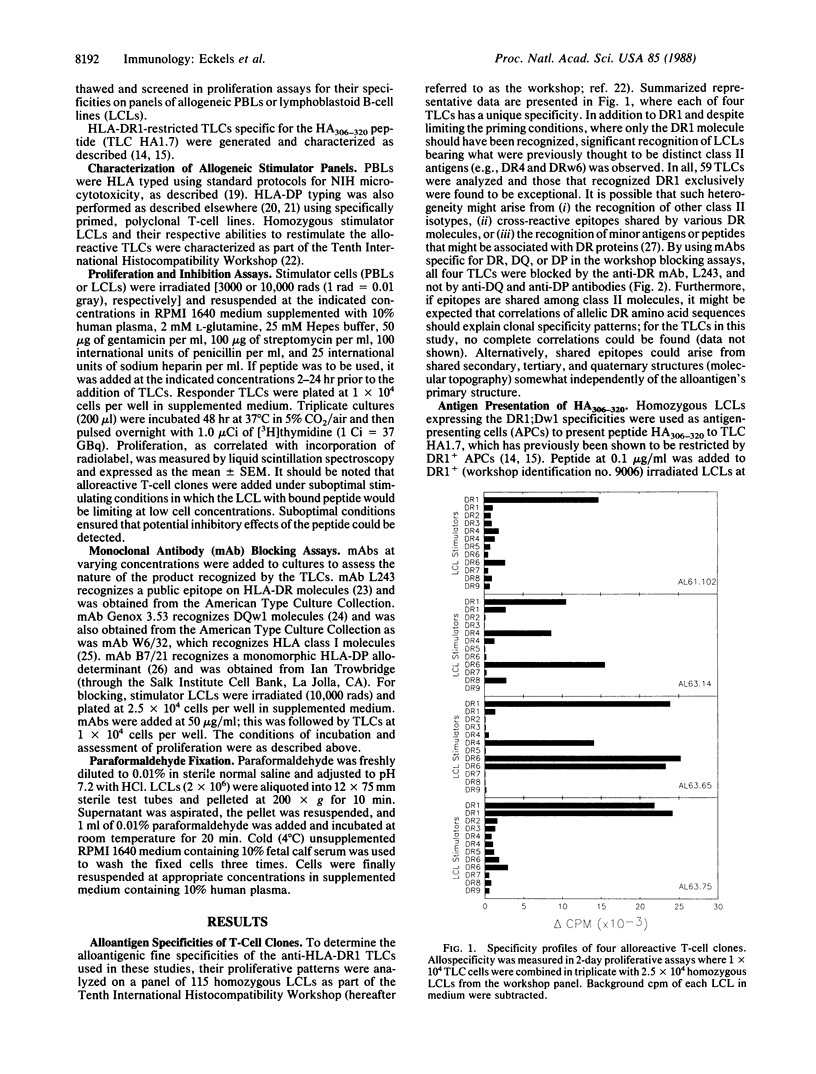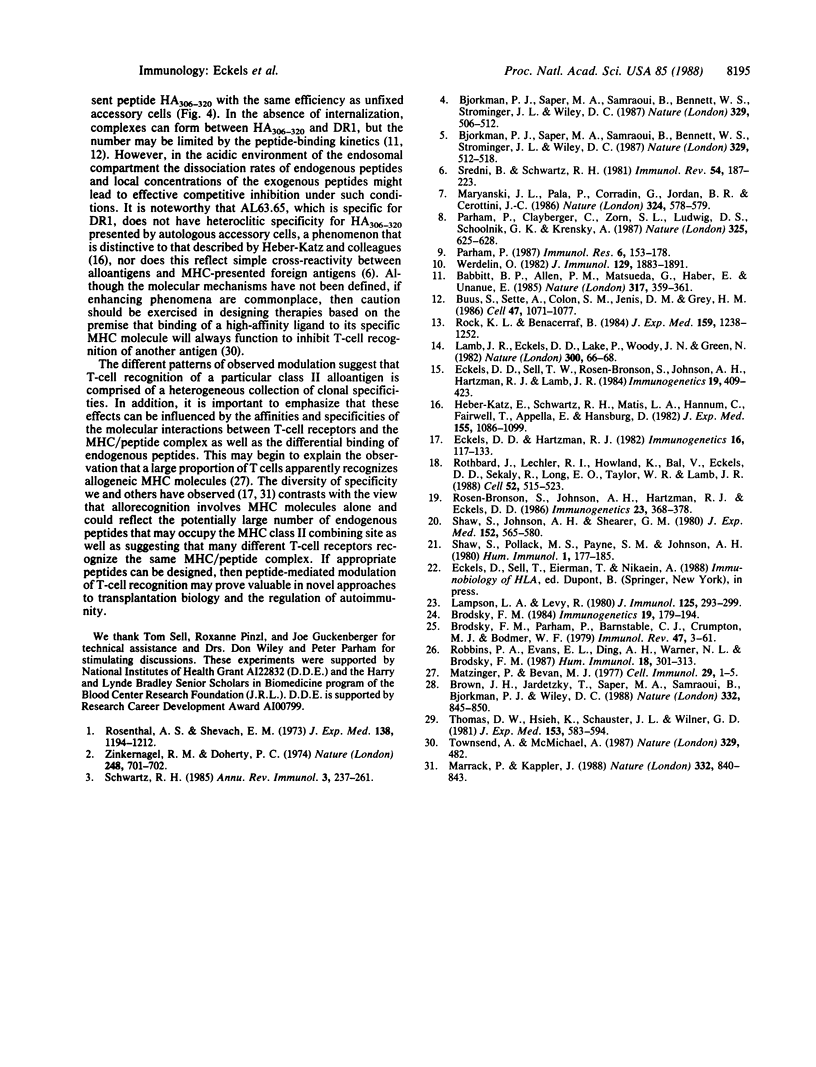Abstract
Antigen-specific helper T cells recognize a complex of peptide antigen and class II major histocompatibility complex (MHC) gene products. Whether T cells recognize MHC class II alloantigen by a similar mechanism or the native conformation of MHC molecules themselves has yet to be determined. The demonstration that peptide antigens bind directly and specifically to class II molecules has allowed us to examine the influence of foreign peptide binding on T-cell recognition of allogeneic MHC molecules. We report here that an immunodominant, HLA-DR1-restricted peptide of influenza virus hemagglutinin (HA residues 306-320) is able to modulate the recognition of alloantigen by human DR1-specific T-cell clones. For some T-cell clones, but not all, the HA peptide inhibited allorecognition in a dose-dependent manner. However, in one instance, the proliferative response to alloantigen was enhanced in the presence of HA peptide. These results suggest that the specificities of T-cell responses to allogeneic MHC molecules are heterogeneous, which may be influenced by different peptides occupying the class II MHC combining site and by the diversity of antigen-specific receptors of T lymphocytes recognizing the same MHC/peptide complex.
Full text
PDF




Selected References
These references are in PubMed. This may not be the complete list of references from this article.
- Babbitt B. P., Allen P. M., Matsueda G., Haber E., Unanue E. R. Binding of immunogenic peptides to Ia histocompatibility molecules. 1985 Sep 26-Oct 2Nature. 317(6035):359–361. doi: 10.1038/317359a0. [DOI] [PubMed] [Google Scholar]
- Bjorkman P. J., Saper M. A., Samraoui B., Bennett W. S., Strominger J. L., Wiley D. C. Structure of the human class I histocompatibility antigen, HLA-A2. Nature. 1987 Oct 8;329(6139):506–512. doi: 10.1038/329506a0. [DOI] [PubMed] [Google Scholar]
- Bjorkman P. J., Saper M. A., Samraoui B., Bennett W. S., Strominger J. L., Wiley D. C. The foreign antigen binding site and T cell recognition regions of class I histocompatibility antigens. Nature. 1987 Oct 8;329(6139):512–518. doi: 10.1038/329512a0. [DOI] [PubMed] [Google Scholar]
- Brodsky F. M. A matrix approach to human class II histocompatibility antigens: reactions of four monoclonal antibodies with the products of nine haplotypes. Immunogenetics. 1984;19(3):179–194. doi: 10.1007/BF00364762. [DOI] [PubMed] [Google Scholar]
- Brodsky F. M., Parham P., Barnstable C. J., Crumpton M. J., Bodmer W. F. Monoclonal antibodies for analysis of the HLA system. Immunol Rev. 1979;47:3–61. doi: 10.1111/j.1600-065x.1979.tb00288.x. [DOI] [PubMed] [Google Scholar]
- Brown J. H., Jardetzky T., Saper M. A., Samraoui B., Bjorkman P. J., Wiley D. C. A hypothetical model of the foreign antigen binding site of class II histocompatibility molecules. Nature. 1988 Apr 28;332(6167):845–850. doi: 10.1038/332845a0. [DOI] [PubMed] [Google Scholar]
- Buus S., Sette A., Colon S. M., Jenis D. M., Grey H. M. Isolation and characterization of antigen-Ia complexes involved in T cell recognition. Cell. 1986 Dec 26;47(6):1071–1077. doi: 10.1016/0092-8674(86)90822-6. [DOI] [PubMed] [Google Scholar]
- Eckels D. D., Hartzman R. J. Characterization of human T-lymphocyte clones (TLCs) specific for HLA-region gene products. Immunogenetics. 1982;16(2):117–133. doi: 10.1007/BF00364399. [DOI] [PubMed] [Google Scholar]
- Eckels D. D., Sell T. W., Bronson S. R., Johnson A. H., Hartzman R. J., Lamb J. R. Human helper T-cell clones that recognize different influenza hemagglutinin determinants are restricted by different HLA-D region epitopes. Immunogenetics. 1984;19(5):409–423. doi: 10.1007/BF00364644. [DOI] [PubMed] [Google Scholar]
- Heber-Katz E., Schwartz R. H., Matis L. A., Hannum C., Fairwell T., Appella E., Hansburg D. Contribution of antigen-presenting cell major histocompatibility complex gene products to the specificity of antigen-induced T cell activation. J Exp Med. 1982 Apr 1;155(4):1086–1099. doi: 10.1084/jem.155.4.1086. [DOI] [PMC free article] [PubMed] [Google Scholar]
- Lamb J. R., Eckels D. D., Lake P., Woody J. N., Green N. Human T-cell clones recognize chemically synthesized peptides of influenza haemagglutinin. Nature. 1982 Nov 4;300(5887):66–69. doi: 10.1038/300066a0. [DOI] [PubMed] [Google Scholar]
- Lampson L. A., Levy R. Two populations of Ia-like molecules on a human B cell line. J Immunol. 1980 Jul;125(1):293–299. [PubMed] [Google Scholar]
- Marrack P., Kappler J. T cells can distinguish between allogeneic major histocompatibility complex products on different cell types. Nature. 1988 Apr 28;332(6167):840–843. doi: 10.1038/332840a0. [DOI] [PubMed] [Google Scholar]
- Maryanski J. L., Pala P., Corradin G., Jordan B. R., Cerottini J. C. H-2-restricted cytolytic T cells specific for HLA can recognize a synthetic HLA peptide. Nature. 1986 Dec 11;324(6097):578–579. doi: 10.1038/324578a0. [DOI] [PubMed] [Google Scholar]
- Matzinger P., Bevan M. J. Hypothesis: why do so many lymphocytes respond to major histocompatibility antigens? Cell Immunol. 1977 Mar 1;29(1):1–5. doi: 10.1016/0008-8749(77)90269-6. [DOI] [PubMed] [Google Scholar]
- Parham P., Clayberger C., Zorn S. L., Ludwig D. S., Schoolnik G. K., Krensky A. M. Inhibition of alloreactive cytotoxic T lymphocytes by peptides from the alpha 2 domain of HLA-A2. Nature. 1987 Feb 12;325(6105):625–628. doi: 10.1038/325625a0. [DOI] [PubMed] [Google Scholar]
- Parham P. Functional sites of human class I MHC molecules: paradigms a dozen? Immunol Res. 1987;6(3):153–178. doi: 10.1007/BF02918089. [DOI] [PubMed] [Google Scholar]
- Robbins P. A., Evans E. L., Ding A. H., Warner N. L., Brodsky F. M. Monoclonal antibodies that distinguish between class II antigens (HLA-DP, DQ, and DR) in 14 haplotypes. Hum Immunol. 1987 Apr;18(4):301–313. doi: 10.1016/0198-8859(87)90077-2. [DOI] [PubMed] [Google Scholar]
- Rock K. L., Benacerraf B. Selective modification of a private I-A allo-stimulating determinant(s) upon association of antigen with an antigen-presenting cell. J Exp Med. 1984 Apr 1;159(4):1238–1252. doi: 10.1084/jem.159.4.1238. [DOI] [PMC free article] [PubMed] [Google Scholar]
- Rosen-Bronson S., Johnson A. H., Hartzman R. J., Eckels D. D. Human allospecific TLCs generated against HLA antigens associated with DR1 through DRw8. I. Growth and specificity analysis. Immunogenetics. 1986;23(6):368–378. doi: 10.1007/BF00372669. [DOI] [PubMed] [Google Scholar]
- Rosenthal A. S., Shevach E. M. Function of macrophages in antigen recognition by guinea pig T lymphocytes. I. Requirement for histocompatible macrophages and lymphocytes. J Exp Med. 1973 Nov 1;138(5):1194–1212. doi: 10.1084/jem.138.5.1194. [DOI] [PMC free article] [PubMed] [Google Scholar]
- Rothbard J. B., Lechler R. I., Howland K., Bal V., Eckels D. D., Sekaly R., Long E. O., Taylor W. R., Lamb J. R. Structural model of HLA-DR1 restricted T cell antigen recognition. Cell. 1988 Feb 26;52(4):515–523. doi: 10.1016/0092-8674(88)90464-3. [DOI] [PubMed] [Google Scholar]
- Schwartz R. H. T-lymphocyte recognition of antigen in association with gene products of the major histocompatibility complex. Annu Rev Immunol. 1985;3:237–261. doi: 10.1146/annurev.iy.03.040185.001321. [DOI] [PubMed] [Google Scholar]
- Shaw S., Johnson A. H., Shearer G. M. Evidence for a new segregant series of B cell antigens that are encoded in the HLA-D region and that stimulate secondary allogenic proliferative and cytotoxic responses. J Exp Med. 1980 Sep 1;152(3):565–580. doi: 10.1084/jem.152.3.565. [DOI] [PMC free article] [PubMed] [Google Scholar]
- Shaw S., Pollack M. S., Payne S. M., Johnson A. H. HLA-linked B cell alloantigens of a new segregant series: population and family studies of the SB antigens. Hum Immunol. 1980 Sep;1(2):177–185. doi: 10.1016/0198-8859(80)90104-4. [DOI] [PubMed] [Google Scholar]
- Sredni B., Schwartz R. H. Antigen-specific, proliferating T lymphocyte clones. Methodology, specificity, MHC restriction and alloreactivity. Immunol Rev. 1981;54:187–223. doi: 10.1111/j.1600-065x.1981.tb00438.x. [DOI] [PubMed] [Google Scholar]
- Thomas D. W., Hsieh K. H., Schauster J. L., Wilner G. D. Fine specificity of genetic regulation of guinea pig T lymphocyte responses to angiotensin II and related peptides. J Exp Med. 1981 Mar 1;153(3):583–594. doi: 10.1084/jem.153.3.583. [DOI] [PMC free article] [PubMed] [Google Scholar]
- Townsend A., McMichael A. MHC protein structure. Those images that yet fresh images beget. Nature. 1987 Oct 8;329(6139):482–483. doi: 10.1038/329482a0. [DOI] [PubMed] [Google Scholar]
- Werdelin O. Chemically related antigens compete for presentation by accessory cells to T cells. J Immunol. 1982 Nov;129(5):1883–1891. [PubMed] [Google Scholar]
- Zinkernagel R. M., Doherty P. C. Restriction of in vitro T cell-mediated cytotoxicity in lymphocytic choriomeningitis within a syngeneic or semiallogeneic system. Nature. 1974 Apr 19;248(5450):701–702. doi: 10.1038/248701a0. [DOI] [PubMed] [Google Scholar]


